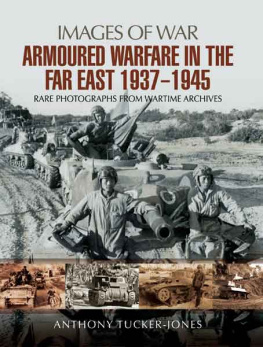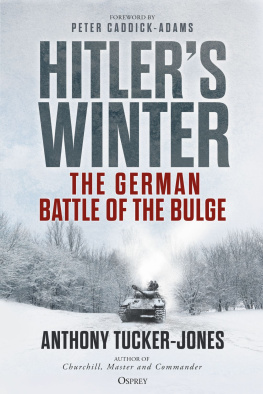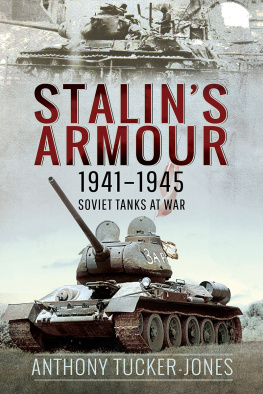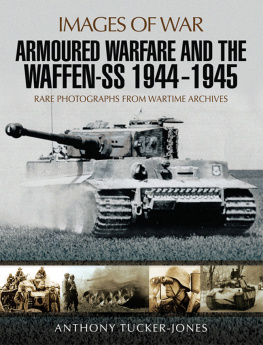
A British M3 Lee medium tank and its happy looking crew on the banks of the Mu River near Chanta, Burma in January 1945. By this stage of the war morale was clearly high.
First published in Great Britain in 2015 by
PEN & SWORD MILITARY
an imprint of
Pen & Sword Books Ltd,
47 Church Street,
Barnsley,
South Yorkshire
S70 2AS
Text copyright Anthony Tucker-Jones, 2015
Photographs copyright as credited, 2015
Every effort has been made to trace the copyright of all the photographs. If there are unintentional omissions, please contact the publisher in writing, who will correct all subsequent editions.
A CIP record for this book is available from the British Library.
ISBN: 978 1 47385 167 2
PDF ISBN: 978 1 47385 170 2
EPUB ISBN: 978 1 47385 168 9
PRC ISBN: 978 1 47385 169 6
The right of Anthony Tucker-Jones to be identified as Author of this Work has been asserted by him in accordance with the Copyright, Designs and Patents Act 1988.
All rights reserved. No part of this book may be reproduced or transmitted in any form or by any means, electronic or mechanical including photocopying, recording or by any information storage and retrieval system, without permission from the Publisher in writing.
Typeset by CHIC GRAPHICS
Printed and bound by CPI Group (UK) Ltd, Croydon, CR0 4YY
Pen & Sword Books Ltd incorporates the imprints of Pen & Sword Archaeology, Atlas, Aviation, Battleground, Discovery, Family History, History, Maritime, Military, Naval, Politics, Railways, Select, Social History, Transport, True Crime, Claymore Press, Frontline Books, Leo Cooper, Praetorian Press, Remember When, Seaforth Publishing and Wharncliffe.
For a complete list of Pen & Sword titles please contact
Pen & Sword Books Limited
47 Church Street, Barnsley, South Yorkshire, S70 2AS, England
E-mail:
Website: www.pen-and-sword.co.uk
Contents
Introduction
O n the very eve of the Second World War on the far side of the sprawling Soviet Union a largely unnoticed, short but brutal border war took place with Japan. Georgi Zhukov and his Red Army tanks inflicted such a devastating blow against the Imperial Japanese Army that it convinced Tokyo to look south for further territorial gains. Few in Europe had heard of Manchuria, let alone Mongolia, indeed at the time the worlds attention was firmly focused on the fate of Czechoslovakia and Poland. In the Far East the long and bloody war between Japan and China was old news, as was Japans creation of the puppet state of Manchukuo from prostrate Manchuria. So some distant border clash between the USSR and Japan seemed of little consequence to Europes diplomats fretting over avoiding war with Hitlers resurgent Germany. The Japanese were taught a highly valuable lesson at the hands of the Red Army about armoured warfare, but crucially they failed to heed it.
On 7 December 1941, Japan struck at Pearl Harbor; the next day Japanese forces occupied Shanghai and Siam (Thailand) and landed in British Malaya. Trundling down the roads through Malayas rubber plantations came Japanese light and medium tanks. These caused chaos and panic and swiftly overran British defences. At Muar Australian anti-tank gunners put up a highly spirited defence but it was to no avail. Twenty-four hours after the invasion of Malaya the Imperial Japanese Navy sank two British battleships, the Repulse and the Prince of Wales, crippling Britains naval strength in the Pacific in one fell swoop. Japan reigned supreme in the air and at sea. On the ground the Japanese Blitzkrieg continued this trend.
Just after the attack on Pearl Harbor the Japanese captured the American island of Guam. In the New Year they attacked the Philippines with tanks spearheading the assault on Luzon. British Hong Kong fell to the Japanese in late December 1941. Shortly after having been driven from Malaya British forces at Singapore surrendered in February 1942. The following month the Japanese occupied most of Java, Sumatra and other islands of the Dutch East Indies. In Burma British and Chinese troops were swiftly driven back toward the Indian border. An Imperial Tokyo communiqu announced on 9 March 1942 that Rangoon, the capital of Burma, had been seized. This threatened India and Chinas western frontier. Japanese tanks then helped humiliate American and Filipino troops trapped at Bataan.
The fighting in China, South-East Asia and the Pacific during the 1930s and 1940s is not generally known for its armoured or mechanised warfare. Nevertheless a wide range of regular armed forces employed armoured vehicles to varying degrees during the various campaigns fought in the Far East and the Pacific, including the American, Australian, British, Chinese, Indian, Russian and Japanese armies. Renegade proxy forces such as the semi-independent Japanese Kwantung Army and the puppet Chinese Manchukuo Imperial Army also deployed tanks.
In all these operations Japanese tanks played a part. Whereas tanks such as the Sherman, Panther, Tiger, T-34 and others have gone down in history as key pieces of equipment, the Japanese Chi-Ha, Ha-Go and I-Go are little known outside military circles. In particular the Type 97 Chi-Ha was the most widely deployed Japanese medium tank of the Second World War but over the years it has gained little fame or notoriety. Once the war began to go against Japan, the priority for aircraft and warships to defend the Japanese homeland ensured that its tank fleet was never very large compared to those of the Western armies.
Geography also played its role in the evolution of armoured warfare in this part of the world. Perhaps understandably at the time, the jungles of Burma, Malaya and Thailand and the coral islands of the Pacific were considered wholly unsuitable tank country. Events were to prove otherwise, but this initial mindset stifled the use of armour.
In contrast the open spaces of Manchuria seemed ideal, but Japanese tanks encountered few Chinese counterparts. Despite being flat, conditions were far from perfect as there were vast areas of marshes and flood plain that were not suitable for vehicles during the wet season. In addition the fertile Manchurian Plain, also known as the North-East China Plain, is very hot during the summer and bitterly cold in the winter. The Japanese came to the conclusion that their existing tanks were fit for purpose and this mentality continued until the very end of the Second World War.
The political complexity of the wars fought in the Far East far outweighed the multinational campaigns fought in North Africa, Italy, France and indeed Russia. In the case of the latter, Germany and Italy were the common enemy. In the Far East all the players had competing goals and alliances of convenience were strained and often short lived. Chinas Nationalist government was fighting to maintain and extend central authority, while Chinas Communists were seeking regime change. Although opposed to each other, both were united in their opposition to Japanese aggression on the Chinese mainland. Caught in the middle were Chinas powerful warlords who maintained strong provincial militias that sided with whoever was in the ascendancy. These militias were often at best simply police forces intent on keeping law and order at worst they were bandits who terrorised the civilian population and took what they wanted.
At the same time Japanese forces in China and Korea were seeking to hold and gain additional Chinese territory. These were supported by collaborationist Chinese and Korean forces that had little option but to cooperate with their colonial masters. Again the latter were little more than militias who normally lacked heavy equipment. Meanwhile the Soviet Union, having tangled with both China and Japan in the 1930s, sought to avoid further war while it concentrated on events unfolding in Europe.
Next page


















